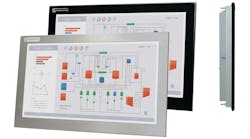In the future, data will move about wirelessly, says Tom McKinney, business development manager at HMS Industrial Networks. "One of the big areas of new technology affecting HMS’s business with machine builders is the use of Wi-Fi,” he explains. "In the past, customers have used Wi-Fi as a cable replacement technology. It eliminated a wire in the customer's OT network."
Now machine builders are adding Wi-Fi capability to machines. "It's being used whether the machine is on the factory floor or a remote-site pump skid," says McKinney. "It's being used to support an HMI that may be on an engineer's or technician's smartphone or tablet."
It's very easy to create this solution, says McKinney. "The tablets and smartphones have high-definition screens, and the software is available to quickly connect and view a variety of HMIs from these handheld devices," he says. "The HMIs with HTML5 solutions are already built in to the machines so little needs to be done to enable this. More machine builders should and will be doing this."
HMS is seeing the growth of edge gateways consolidating data. "A number of machines could feed data to a single gateway," says McKinney. "The gateway could then perform some edge processing on the data to reduce the data sent to the cloud. It would filter the data, if needed, to remove duplicates and provide some basic edge analytics. With just a little processing power at the edge, this could be done for several machines."
Companies, such as IT system integrators, who can run their software on top of an edge gateway platform, are providing their customers the ability to filter data at the edge or even change functionality at the edge, on the fly. "These integrators, using edge gateway hardware, are going to continue to refine the middleware that exists between the edge gateway and any application running in the cloud," says McKinney. "As that happens, it will become easier and easier to filter, analyze and use data at the edge. It is desirable to make decision at the edge, so all the data doesn't need to be pushed to the cloud to make a decision."
Keep in mind that this northbound, upstream connection may need to go to multiple clouds, warns McKinney. "For example, the state utility, equipment vendor and end user may all have their own cloud platforms," he says. "The gateway is the likely source to control the northbound data flow, instead of sending it to a single cloud platform."
This also highlights that the machine builder may need to support different cloud platforms. "Perhaps the edge gateway will be the preferred method as there are many applications in the cloud, about 420 platforms today," says McKinney. "While there are connectors between clouds, they do like to try to silo themselves. The stickier they make the platform, the more likely the users will stay long-term."
Another big area HMS sees emerging is cellular. "I heard at a presentation at the Mobile World Congress (MWC) 2017, in San Francisco, California, that the true cost for cellular data has decreased a hundredfold in the past three years with cellular providers," says McKinney.
Many machines are connected to the cloud today using an existing plant network cable and a VPN solution providing remote access at little cost. "The wires are going away," says McKinney. "The wires will still be there for real-time control, but, for data collection, monitoring and servicing solutions such as VPN access, it's possible all of that will move to a cellular network. In the future, I think the cellular providers will have the pricing to the point where a machine could ship with a SIM card or essentially a gateway with a cellular modem built in to it. That could easily happen in the next five years."
The current cellular data plans may be too pricey. The new LTE Cat. M1 (LTE-M1) low-power cellular technology will mean somewhat lower data rates, more for a temperature sensor, but it doesn't align well with data collection on an active machine, explains McKinney. "It won't be used for a VPN connection to a machine," he says. "However, the bandwidth that is available on LTE makes full data collection and VPN remote access 100% feasible today. It's really just a matter of cost."
McKinney believes the LTE data price will come down in the next few years, making it common to connect to machines with just the LTE network. "If the LTE network can't get it done from a pricing standpoint, the 5G solution that will be available in the next few years definitely will," says McKinney. "There will be so much bandwidth available, they will be looking for ways to sell it."






